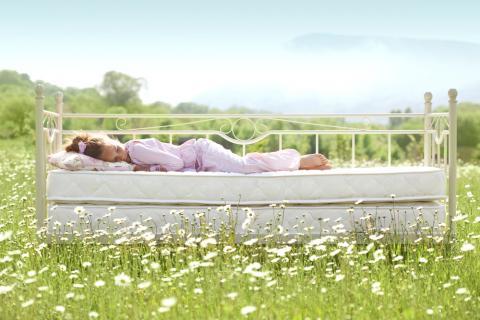
If you’re reading Basmati, chances are you care about your health. You likely invest in organic produce, take yoga classes, meditate, and are wary of the toxic chemicals hiding in everyday cleaning products, make-up, and even water bottles.
But have you ever considered what you’re sleeping on?
For sufficient rest, most people require between 7 and 9 hours of sleep per night, which comes out to more than 2,500 hours each year. In fact, by the end of our lives, most of us will have spent one third of that sleeping. What we’re sleeping on plays a big role in how we feel the next day, and anyone who has spent an agitated night on a creaky motel mattress or without a mattress when camping will understand that this directly affects how we feel the next day. Latex, memory foam, coils, pillow-top, and adjustable are all options, but what the mattress is made up of matters, too.
Here’s why you might need to think twice before you buy a new mattress, or consider upgrading to one that’s organic.
1. Your Mattress Produces Emissions
A study by the Cockrell School of Engineering at the University of Texas at Austin found that infants are exposed to very high levels of chemical emissions from their crib mattresses. Newer mattresses were found to emit much higher levels and in closest proximity to the child’s breathing zone. Unfortunately this wasn’t a single manufacturer issue, either. The study sampled 20 mattresses from 10 different manufacturers. While extended “airing-out” periods helped combat the release of VOCs (volatile organic compounds), emissions were still found. And, although this study was looking specifically at crib mattresses, adult mattresses have similar problems. Formaldehyde, linked to allergies, asthma, and lung cancer, is also used in the production of mattresses, as are cotton pesticides, flame-retardants, and, in some cases, carcinogens like benzene and naphthalene, as this article in Mother Jones suggests.
2. Coil-Spring Mattresses Can Act As Antennae For EMF
It might seem crazy, but a coil-spring mattress can act as antennae for EMF. A fascinating article from Scientific American published in 2010 discusses the correlation between box-spring mattresses, FM and TV radiation, and melanoma and breast cancers.
3. Some Mattresses Hurt Your Body More Than They Help
Mattresses today are almost fully customizable, with softness so plump and delicate that you might feel as though you’re slipping into a bed of clouds. Unfortunately, not all of these mattresses are focused on proper spinal support, meaning that you can wake up the next day—or years down the road—wondering why your lower back is so sore. Popular health and fitness guru Ben Greenfield wrote a long post explaining the problems with conventional mattresses and your health.
What’s the alternative?
Luckily, there’s a plethora of mattresses that don’t release dangerous chemicals, don’t act as radiation antennas, and don’t hurt your body as you sleep.
- You can look for a mattress that provides natural latex support (which supports your spinal column with proper alignment), natural memory foam (to cradle your curves as you sleep on your side), and an organic removable cover.
- For those who aren’t allergic to wool and don’t mind washing their mattress annually, you might seek out organic cotton, natural latex, and natural wool options while ditching the chemical additives and flame retardants of other brands.
Still not convinced? There’s always the option of the Japanese tatami mats. Better yet, head outdoors and camp. Now that’s grounding.








